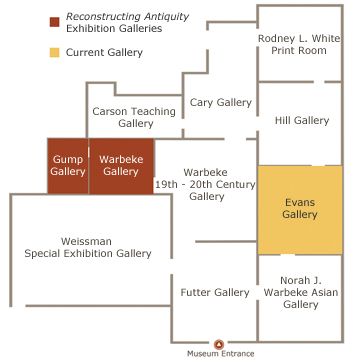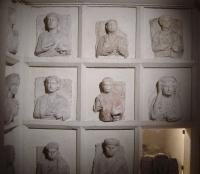Reclining figure of a man at a banquet
Learn more about the object below
The ancient Syrian city of Palmyra was a prosperous commercial center, offering an oasis for caravans traveling between the Persian Gulf and the Mediterranean Sea. Made rich by the trade of goods from East to West, Palmyra rose to become the “pearl” city of lore within the Tadmorean Desert. It maintained some autonomy under its provincial leadership until Queen Zenobia flexed her power in the mid-third century. Her revolt and subsequent capture by Emperor Aurelian precipitated the steady decline of the city and the eventual redirection of caravan routes to Constantinople.
Many wealthy Palmyran merchants buried their dead in elaborate displays of affluence, constructing vertical tower-shaped monuments and expansive underground chambers. Commonly referred to as the “Valley of the Tombs,” a kilometer-long necropolis bordered the city walls and housed over 150 tombs. This fragment of a funerary bust likely sealed off a cubiculum, a compartment housing the mummified body of the deceased set into the wall of a subterranean chamber. Now missing his legs, the figure reclines as if seated at a banquet with his drink in hand. The image at right illustrates the grand scale of some of these funerary tombs, with cubicula sometimes stacked up to ten high.
Label text by Rachel Beaupré, Andrew W. Mellon Assistant Curator, Mount Holyoke College Art Museum.
Suggested readings:
Cussini, Eleonora. “Beyond the Spindle: Investigating the Role of Palmyrene Women.” Journey to Palmyra: Collected Essays to Remember Delbert R. Hillers. Leiden: Brill Academic Publishers, 2005.
Dien, Albert E., “Palmyra as a Caravan City,” Cities and Architecture along the Silk Road. University of Washington, 2011.
Stoneman, Richard. Palmyra and Its Empire: Zenobia's Revolt Against Rome. Ann Arbor: University of Michigan Press, 1992.
Heyn, Maura. “Gesture and Identity in the Funerary Art of Palmyra.” American Journal of Archaeology, Vol. 114, No. 4 (Oct. 2010).




